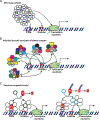MYC: a complex problem
- PMID: 35963793
- PMCID: PMC9911561
- DOI: 10.1016/j.tcb.2022.07.006
MYC: a complex problem
Abstract
The MYC protooncogene functions as a universal amplifier of transcription through interaction with numerous factors and complexes that regulate almost every cellular process. However, a comprehensive model that explains MYC's actions and the interplay governing the complicated dynamics of components of the transcription and replication machinery is still lacking. Here, we review the potency of MYC as an oncogenic driver and how it regulates the broad spectrum of complexes (effectors and regulators). We propose a 'hand-over model' for differential partitioning and trafficking of unstructured MYC via a loose interaction network between various gene-regulatory complexes and factors. Additionally, the article discusses how unstructured-MYC energetically favors efficient modulation of the energy landscape of the transcription cycle.
Keywords: DNA topology; MYC; MYC–topoisome complex; RNA polymerase; intrinsically disordered proteins; multistep reactions; protein complexes; topoisomerase; transcription cycle.
Published by Elsevier Ltd.
Conflict of interest statement
Declaration of interests The authors declare no competing interests.
Figures


References
-
- Roussel M, et al., Three new types of viral oncogene of cellular origin specific for haematopoietic cell transformation. Nature, 1979. 281(5731): p. 452–5. - PubMed
Publication types
MeSH terms
Substances
Grants and funding
LinkOut - more resources
Full Text Sources
Other Literature Sources

